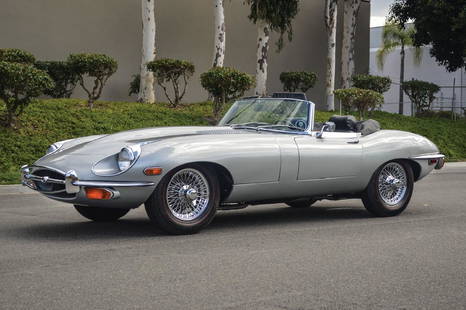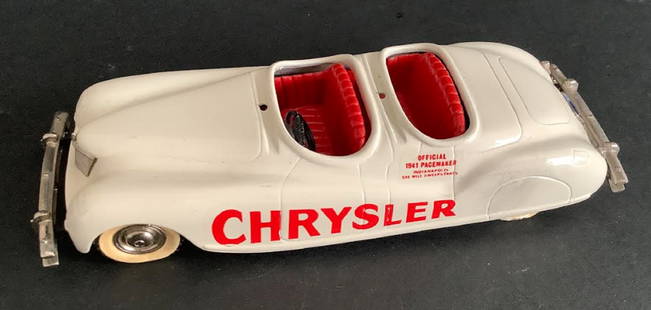
1937 Jaguar SS100 2½-Litre Roadster Chassis no.
Similar Sale History
View More Items in Cars



Related Cars
More Items in Cars
View MoreRecommended Cars & Motors
View More





















Item Details
Description
1937 Jaguar SS100 2½-Litre Roadster
Registration no. AUK 634
Chassis no. 18109
*One of circa 191 2½-Litre models built
*Scottish and Welsh rallies participant in 1938/1939
*Matching numbers
*Single owner from 1938 to 1994
*Professionally restored by Davenport Cars
Footnotes:
Launched for 1936, the SS100 was the first real high-performance model produced by SS Cars Limited and used a new Weslake-developed overhead-valve engine in a shortened SS1 chassis. The introduction of the OHV unit was considered to justify the adoption of a new name for the series, SS Cars boss William Lyons later recalling 'I immediately pounced on Jaguar as it had an exciting sound to me.' ('Jaguar' would be adopted as the marque name in 1943, 'SS' having by then acquired a somewhat tarnished reputation).
'SS' originally stood for the Swallow Sidecar & Coachbuilding Company, which had been founded in Blackpool, England by William Walmsley. The company branched out into motor manufacture in 1926, its first major success being an attractive sports saloon on the Austin Seven chassis, the design being the work of Walmsley's partner, one William Lyons. Relocation to Coventry followed and the Swallow range expanded to include models on Morris Cowley, Wolseley Hornet and Standard Sixteen chassis. Marque status arrived in October 1931 with the launch of the SS1, the chassis of which was supplied exclusively to Swallow by Standard, who also provided the six-cylinder sidevalve engine and four-speed gearbox. Although unspectacular in performance, the SS1 went some way towards establishing the pattern for future Jaguars, combining sporting good looks with a better-than-average specification and all at a bargain price.
By the time the SS90 sports car arrived in 1935, William Heynes had joined as Chief Engineer. Based on a shortened SS1 chassis, re-engineered by Heynes, the SS90 again demonstrated Lyons' consummate skill as a stylist, its long bonnet, smoothly flowing wings, cut-away doors and truncated tail making it every inch the epitome of the 1930s sports car. Although good for 90mph, the SS90 was handicapped by the limitations of its sidevalve engine, a deficiency that would soon be rectified by another of Lyons' new recruits, gas-flow consultant Harry Weslake. Launched in 1936 alongside the 2½-Litre saloon, the SS100 Jaguar sports car marked the company's first use of the 'Jaguar' name. Beautifully styled in the manner of its SS90 predecessor, the newcomer employed a shorter, 102'-wheelbase chassis and a revised version of the 2,663cc Standard six which, equipped with Weslake's overhead-valve cylinder head and breathing through twin SU carburettors, now produced 104bhp.
Although a fine touring car, the SS 100 was marketed as primarily for competition work. Its first major success came early, if somewhat unexpectedly, when Tommy Wisdom, crewed by his wife, won the arduous International Alpine Trial in 1936, beating Bugatti and bringing the fledgling marque to the attention of the Continental public. This would be the first of many successful rallying forays, including class wins in the RAC events of 1937 and 1938, and the Alpine (outright) again in 1948. A total of 191 2½-Litre and 118 of the later 3½-Litre cars had been made by the time SS 100 production was prematurely ended by the outbreak of war.
This original 2½-litre SS100 is a matching numbers car that comes with a well documented history. Chassis number '18109' was first registered on 11th June 1937 and delivered new by Attwoods, an SS dealer based in Wolverhampton, to a Mr John Fellows. It was subsequently sold (on 6th October 1938) to John Montgomery, a Kentish hop farmer. Mr Montgomery was a rallying enthusiast who campaigned the SS in 1938/1939 in the Scottish and Welsh rallies (see photographs on file).
He kept the SS for the rest of his life, initially using it on the roads, but by the 1960s the car was used only to drive around his hop farm. The car remained totally original apart from the addition of a pair of rear lights and replacement of the horn grilles. Eventually it was put away in a barn, remaining there until after his death, and was sold at auction in 1994 as a 'barn find'.
The present owner purchased the SS in 1996 and instructed marque specialists, Davenport Cars, to carry out a complete restoration. 'AUK 634' is presented in its original factory colour scheme of black with red leather interior and has been fitted with a five-speed synchromesh gearbox (original gearbox supplied). The car is offered in excellent condition.
The SS100 was one of the fastest and best-handling sports cars of its day, as its competition record both before and after the war bears witness to. Representing a rare opportunity to acquire an example of the model that can be said to have started the Jaguar legend, '18109' is eligible for a wide variety of the most prestigious historic motor sports events.
Registration no. AUK 634
Chassis no. 18109
*One of circa 191 2½-Litre models built
*Scottish and Welsh rallies participant in 1938/1939
*Matching numbers
*Single owner from 1938 to 1994
*Professionally restored by Davenport Cars
Footnotes:
Launched for 1936, the SS100 was the first real high-performance model produced by SS Cars Limited and used a new Weslake-developed overhead-valve engine in a shortened SS1 chassis. The introduction of the OHV unit was considered to justify the adoption of a new name for the series, SS Cars boss William Lyons later recalling 'I immediately pounced on Jaguar as it had an exciting sound to me.' ('Jaguar' would be adopted as the marque name in 1943, 'SS' having by then acquired a somewhat tarnished reputation).
'SS' originally stood for the Swallow Sidecar & Coachbuilding Company, which had been founded in Blackpool, England by William Walmsley. The company branched out into motor manufacture in 1926, its first major success being an attractive sports saloon on the Austin Seven chassis, the design being the work of Walmsley's partner, one William Lyons. Relocation to Coventry followed and the Swallow range expanded to include models on Morris Cowley, Wolseley Hornet and Standard Sixteen chassis. Marque status arrived in October 1931 with the launch of the SS1, the chassis of which was supplied exclusively to Swallow by Standard, who also provided the six-cylinder sidevalve engine and four-speed gearbox. Although unspectacular in performance, the SS1 went some way towards establishing the pattern for future Jaguars, combining sporting good looks with a better-than-average specification and all at a bargain price.
By the time the SS90 sports car arrived in 1935, William Heynes had joined as Chief Engineer. Based on a shortened SS1 chassis, re-engineered by Heynes, the SS90 again demonstrated Lyons' consummate skill as a stylist, its long bonnet, smoothly flowing wings, cut-away doors and truncated tail making it every inch the epitome of the 1930s sports car. Although good for 90mph, the SS90 was handicapped by the limitations of its sidevalve engine, a deficiency that would soon be rectified by another of Lyons' new recruits, gas-flow consultant Harry Weslake. Launched in 1936 alongside the 2½-Litre saloon, the SS100 Jaguar sports car marked the company's first use of the 'Jaguar' name. Beautifully styled in the manner of its SS90 predecessor, the newcomer employed a shorter, 102'-wheelbase chassis and a revised version of the 2,663cc Standard six which, equipped with Weslake's overhead-valve cylinder head and breathing through twin SU carburettors, now produced 104bhp.
Although a fine touring car, the SS 100 was marketed as primarily for competition work. Its first major success came early, if somewhat unexpectedly, when Tommy Wisdom, crewed by his wife, won the arduous International Alpine Trial in 1936, beating Bugatti and bringing the fledgling marque to the attention of the Continental public. This would be the first of many successful rallying forays, including class wins in the RAC events of 1937 and 1938, and the Alpine (outright) again in 1948. A total of 191 2½-Litre and 118 of the later 3½-Litre cars had been made by the time SS 100 production was prematurely ended by the outbreak of war.
This original 2½-litre SS100 is a matching numbers car that comes with a well documented history. Chassis number '18109' was first registered on 11th June 1937 and delivered new by Attwoods, an SS dealer based in Wolverhampton, to a Mr John Fellows. It was subsequently sold (on 6th October 1938) to John Montgomery, a Kentish hop farmer. Mr Montgomery was a rallying enthusiast who campaigned the SS in 1938/1939 in the Scottish and Welsh rallies (see photographs on file).
He kept the SS for the rest of his life, initially using it on the roads, but by the 1960s the car was used only to drive around his hop farm. The car remained totally original apart from the addition of a pair of rear lights and replacement of the horn grilles. Eventually it was put away in a barn, remaining there until after his death, and was sold at auction in 1994 as a 'barn find'.
The present owner purchased the SS in 1996 and instructed marque specialists, Davenport Cars, to carry out a complete restoration. 'AUK 634' is presented in its original factory colour scheme of black with red leather interior and has been fitted with a five-speed synchromesh gearbox (original gearbox supplied). The car is offered in excellent condition.
The SS100 was one of the fastest and best-handling sports cars of its day, as its competition record both before and after the war bears witness to. Representing a rare opportunity to acquire an example of the model that can be said to have started the Jaguar legend, '18109' is eligible for a wide variety of the most prestigious historic motor sports events.
Buyer's Premium
- 27.5% up to £10,000.00
- 25% up to £450,000.00
- 20% above £450,000.00
1937 Jaguar SS100 2½-Litre Roadster Chassis no.
Estimate £320,000 - £380,000
3 bidders are watching this item.
Shipping & Pickup Options
Item located in Chichester, England, ukSee Policy for Shipping
Payment

Auction Curated By

Specialist - Automobilia
TOP









































